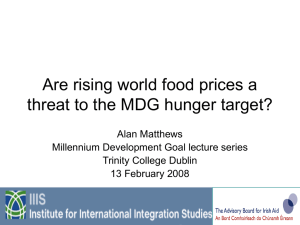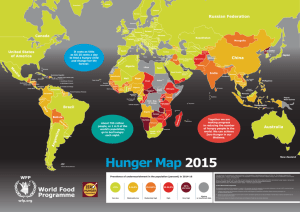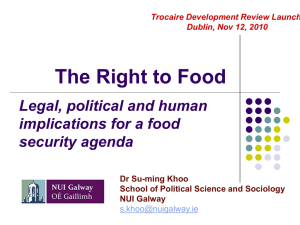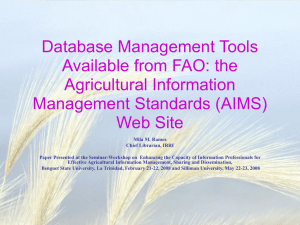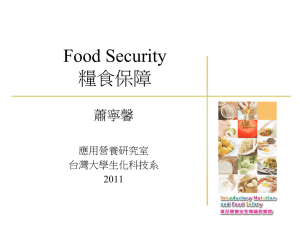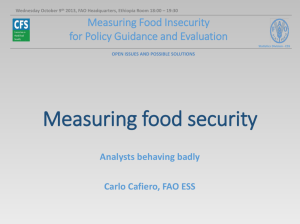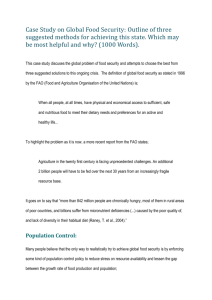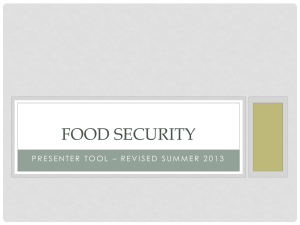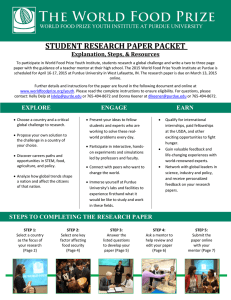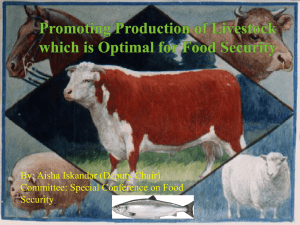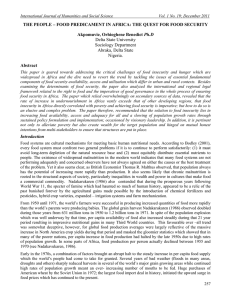KGA171-L5.2-2010
advertisement
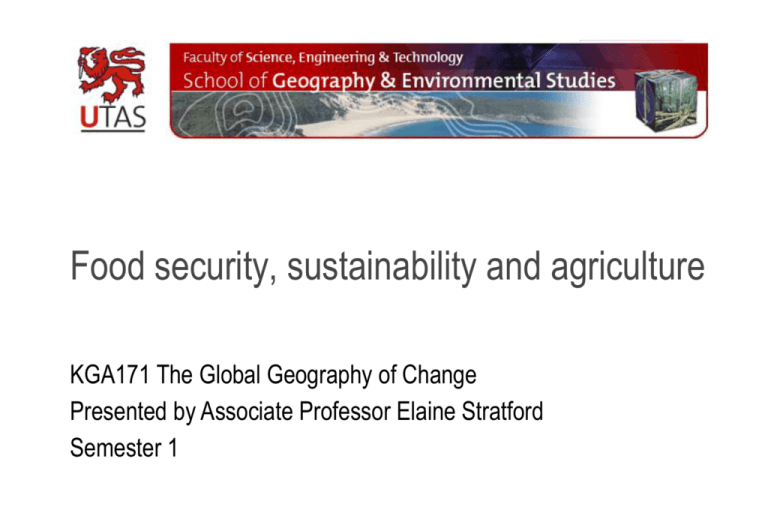
Food security, sustainability and agriculture KGA171 The Global Geography of Change Presented by Associate Professor Elaine Stratford Semester 1 YouTube Introduction Part 1 LOOKING BACK, LOOKING FORWARD Revising Lecture 5.1 1. What is the ecological footprint? 2. With reference to language explain why declining cultural diversity is an environmental problem. 3. Define sustainability. How does it differ from sustainable development? 4. Why are these terms contested? Is that contestation necessarily negative? 5. What are Jacobs’ four faultlines of contestation over sustainable development and how do they gain expression in conservative and radical forms? 6. How was sustainable development fully defined in Our Common Future by the World Commission on Environment and Development/Brundtland Commission? Why does this definition – more than the popular one – matter? 7. List and briefly explain the six principles of sustainability. 8. What is Agenda 21? A Woman Thinking Learning Objectives Module 5 Lecture 2 be able to • explain the meaning, possible causes and spatial expressions of hunger and over-consumption of food • describe and elucidate the main features of the third agricultural revolution • comprehend the ways in which food security and modern agricultural practices are key considerations for sustainable development KGA171 demonstrate knowledge of geographical concepts, earth and social systems and spatial patterns of change create and interpret basic maps, graphs and field data identify and analyse different viewpoints to contribute to debates about global development communicate in reflective and academic writing, referencing literature when needed Textbook Reading Bergman and Renwick (2008) pp.312-51 Food and Agriculture Organization (2006)The State of Food Insecurity in the World 2006, FAO, Rome. Food and Agriculture Organization (FAO) Success stories. Critical reading 1. What is the author’s purpose? 2. What key questions or problems does the author raise? 3. What information, data and evidence does the author present? 4. What key concepts does the author use to organize this information, this evidence? 5. What key conclusions is the author coming to? Are those conclusions justified? 6. What are the author’s primary assumptions? 7. What viewpoints is the author writing from? 8. What are the implications of the author’s reasoning? [from Foundation for Critical Thinking] Old Woman Reading a Lectionary, Gerard Dou Part 2 FOOD SECURITY: AN IMPERATIVE OF SUSTAINABILITY Agenda 21 3. Combating poverty 4. Changing consumption patterns 14. Promoting sustainable agriculture and rural development 32. Strengthening the role of farmers What’s at issue? Chronic hunger Acute hunger Starvation Obesity Food (in)security Unsustainable development Geopolitics of deprivation Poverty Environmental degradation Depletion of natural resources Population growth Loss of ownership or access to land Marginal agricultural land Cash cropping Social conflict Corruption Agri-food markets Hunger is not new Progress Toward Millennium Goal 1 Eradicate extreme poverty and hunger Undernourishment Bergman and Renwick (2008) p.339. Agricultural Labour Force Bergman and Renwick (2008, p.494) Human development Food crises FAO (2008)The State of Food Insecurity in the World 2008, FAO, Rome, p.18. An unequal world Target 420m FAO (2006) The State of Food Insecurity in the World 2006, FAO, Rome, p.5. 2005-2007 food prices rising, hunger increasing number of undernourished people in 2007 923 million – up 75 million from 2005 FAO (2008)The State of Food Insecurity in the World 2008, FAO, Rome, p.6. Geopolitics of excess? Peak water Peak oil Price setting World trade Consumerism Social conflict Excess is not new OECD obesity levels Unprecedented production: grain WorldWatch Institute (2007) Vital Signs 2007-08: The trends that are shaping our future, WW Norton, New York, p.21. Unprecedented production: meat WorldWatch Institute (2007) Vital Signs 2007-08: The trends that are shaping our future, WW Norton, New York, p.21. Unprecedented production: fish WorldWatch Institute (2007) Vital Signs 2007-08: The trends that are shaping our future, WW Norton, New York, p.21. Part 3 OF REVOLUTIONS AND BUSINESS The geography of human history: from local to global Three agricultural revolutions 1st 10,000-5,000 BP Hunter-gatherers Local mini-systems Spatial independence 2nd 1600-1900 3rd 1900 to present Tribes Chiefdoms Empires World-system Regional world-empires Global world-system Spatial interdependence Global spatial integration of agriculture has concentrated control of the world’s food in the core See also Svalbard Seed Bank The Third Agricultural Revolution Robots packing bread onto palettes The Green Revolution Food in the modern world system: inequality and agriculture Bergman and Renwick (2008) p.327. Food supply chain: Five components and mediating forces At the heart of the matter
